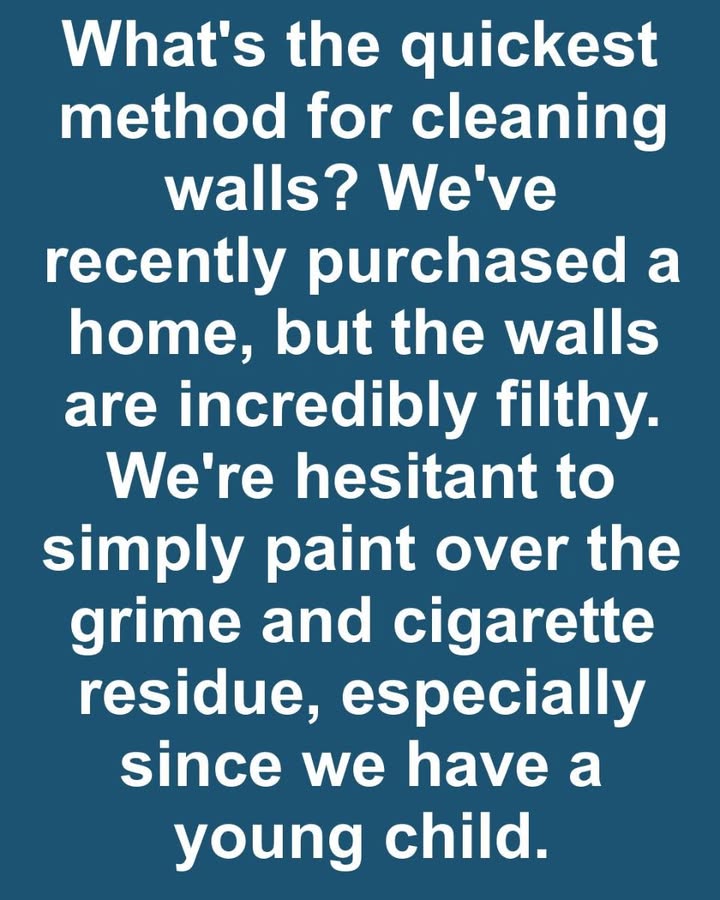Keeping your walls clean is a vital part of maintaining a healthy and comfortable home, especially if you’ve recently purchased a house where dirt, stains, or smoke residue are visible. While it might be tempting to simply paint over the mess for a quick solution, that approach can lead to problems later on.

If the underlying grime isn’t addressed first, you risk paint peeling, uneven texture, and lingering odors that compromise both the look of your walls and the health of your home’s air quality. This is especially important in homes with children, where exposure to allergens, mold, or smoke residue can have real health implications. The first step in tackling dirty walls is carefully assessing their condition. Walk through each room and look for signs like yellowing, streaks, sticky patches, or faint odors that often point to cigarette smoke or built-up grime. Identifying the worst areas will help you determine which parts need a deep clean and which might only require light maintenance. Ignoring these signs and choosing to paint over them could result in a waste of time and money, as the paint won’t properly bond to the wall surface and the smell or stains may eventually seep through.
Once you’ve assessed your walls, gather the right supplies before diving into the cleaning process. You’ll need microfiber cloths, non-abrasive sponges, buckets, a mop with an extended handle for hard-to-reach areas, rubber gloves, and drop cloths or plastic sheets to protect your floors and furniture. In terms of cleaning agents, trisodium phosphate (TSP) is highly effective for tackling cigarette residue and heavy stains, while vinegar and baking soda are excellent natural options for general grime. If your walls are painted with flat or matte finishes, be sure to test a small area first, as these finishes can be more sensitive to harsh cleaners.
Preparing the space before cleaning will make the job easier and prevent unnecessary mess. Move as much furniture as possible away from the walls and cover anything remaining with plastic sheeting. Protect baseboards, electrical outlets, and light switches with painter’s tape, and place towels or drop cloths on the floor to catch any drips. This preparation saves time during cleanup and keeps your belongings safe from moisture and chemicals. When it comes to cleaning different types of stains, not all products work the same. TSP is the go-to choice for removing nicotine and tar stains left behind by cigarette smoke. For more general buildup, a solution of warm water and white vinegar is safe and effective.
If you discover mold on the walls, it’s essential to treat it with a diluted bleach solution that can kill the spores and help prevent them from coming back. To clean cigarette residue, begin by dusting the walls with a dry cloth to remove surface particles. Then, mix TSP with water according to the package instructions, and apply it to the wall using a sponge or mop, working from the bottom up to prevent streaks. Afterward, rinse the walls with clean water and dry them thoroughly with towels. For particularly stubborn areas, try using a paste of baking soda and water, scrubbing gently and rinsing afterward. Mold-affected areas should be scrubbed with a bleach solution and allowed to dry completely to prevent further growth. In homes with children, safety is always a top priority, so choosing non-toxic cleaning options is wise. Vinegar and baking soda are child-safe and effective for many household cleaning needs. You can even add a few drops of essential oils like tea tree or lavender, which have natural antibacterial properties and provide a pleasant, chemical-free scent. Make sure the space is well-ventilated during and after cleaning—open windows, turn on fans, and consider using a dehumidifier if you live in a humid climate. This helps remove any lingering odors and speeds up the drying process. If you’re dealing with walls that are heavily soiled or if the project feels overwhelming, hiring a professional cleaning service can be a smart investment. Professionals have access to industrial-grade tools and products that can restore your walls quickly and safely. Whether you clean the walls yourself or call in the pros, always keep cleaning supplies locked away and out of children’s reach, and never let kids near damp walls until they’re fully dry. By making wall cleaning part of your regular home maintenance routine—through occasional dusting, prompt spot-cleaning, and annual deep cleans—you can protect your home’s appearance and your family’s health in the long term.





